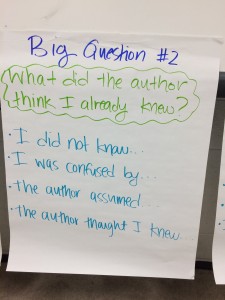Book Review: Reading Nonfiction
 A few months back, I wrote about how great Kylene Beers and Robert Probst’s book Notice & Note was. As soon as I got wind that Beers and Probst would be releasing a nonfiction version, Reading Nonfiction: Notice & Note Stances, Signposts, and Strategies, I quickly headed over to Amazon and pre-ordered my copy—and I have not been disappointed!
A few months back, I wrote about how great Kylene Beers and Robert Probst’s book Notice & Note was. As soon as I got wind that Beers and Probst would be releasing a nonfiction version, Reading Nonfiction: Notice & Note Stances, Signposts, and Strategies, I quickly headed over to Amazon and pre-ordered my copy—and I have not been disappointed!
As much as I loved Notice & Note and made it an integral part of how I teach reading, I think I love Reading Nonfiction even more. As I read, I kept finding myself nodding and, in my head, yelling, “Yes! Why didn’t I think of that before?!”
The Importance of Critical Reading
One of the concepts that struck me the most, and I really couldn’t believe that I had not thought about it before, was the idea that many times, we teach nonfiction as being simply not fiction, which is much too simple a definition and one that can lead inexperienced readers down the wrong path. If we say that fiction texts are not true, then we’re also implying that nonfiction texts are true, which can be a dangerous assumption to make.
Beers and Probst complicate this true/not true definition, but also bring it closer to helping students understand that readers of nonfiction need to be critical, informed readers and not just passive ones being taken in by a story. They define nonfiction as a “body of work in which the author purports to tell us about the real world, a real experience, a real person, an idea, or a belief” (21).
Clearly, the key word in this definition is purports, which signals to students that what they are about to read is always going to be someone’s version of what is real, and that we cannot always take what we read at face value, a necessary skill students need to develop as they are bombarded with information on a daily basis.
The Book’s Elements
Notice & Note was broken down into six signposts, elements that the authors claim are common to the majority of YA novels, and which help to focus students’ thinking. Reading Nonfiction is set up a bit differently; it is broken down like this:
Big Questions
- What surprised you?
- What did the author think you already knew?
- What changed, challenged, or confirmed what you already knew?
Signposts
- Contrasts and Contradictions
- Extreme or Absolute Language
- Numbers and Stats
- Quoted Words
- Word Gaps
Fix-Up Strategies
- Possible Sentences
- KWL 2.0
- Somebody Wanted But So
- Syntax Surgery
- Sketch to Stretch
- Genre Reformulation
- Poster
The Big Questions are the kinds of questions that experienced readers of nonfiction keep in mind as they read, and help students read closely rather than have their eyes skim words on a page. The Signposts help students read closely for features and concepts often found in nonfiction. The Fix-Up Strategies are designed to help when students’ understanding has broken down and can be used before, during, and after reading.
So far, I have begun using the Big Questions with my struggling 6th grade readers. My students are surprising me with how much they are marking and are able to talk about, because they developed this questioning stance before reading. After we tried out the Big Questions, I asked them if they thought this helped them read and understand in a way they wouldn’t have otherwise, and they insightfully indicated how reading with these questions in mind helped them focus on the article and think about it differently.
What is maybe most amazing about this book is that it’s not made just for ELA teachers. As I was reading, I could picture how these concepts could be applied to all content areas, and I wished that every teacher in my building would read this book. This just may have to be our staff’s next book study!
 Jianna Taylor (@JiannaTaylor) is an ELA and Title 1 teacher at Orchard Lake Middle School in West Bloomfield. She is a member of the AVID Site Team and Continuous School Improvement Team at her school, among other things. She is also a MiELA Network Summer Institute facilitator and member of the OWP Core Leadership Team. Jianna earned her bachelor’s degree from Oakland University and her master’s degree from the University of Michigan. She also writes reviews of children’s books and young adult novels for the magazine School Library Connection.
Jianna Taylor (@JiannaTaylor) is an ELA and Title 1 teacher at Orchard Lake Middle School in West Bloomfield. She is a member of the AVID Site Team and Continuous School Improvement Team at her school, among other things. She is also a MiELA Network Summer Institute facilitator and member of the OWP Core Leadership Team. Jianna earned her bachelor’s degree from Oakland University and her master’s degree from the University of Michigan. She also writes reviews of children’s books and young adult novels for the magazine School Library Connection.

